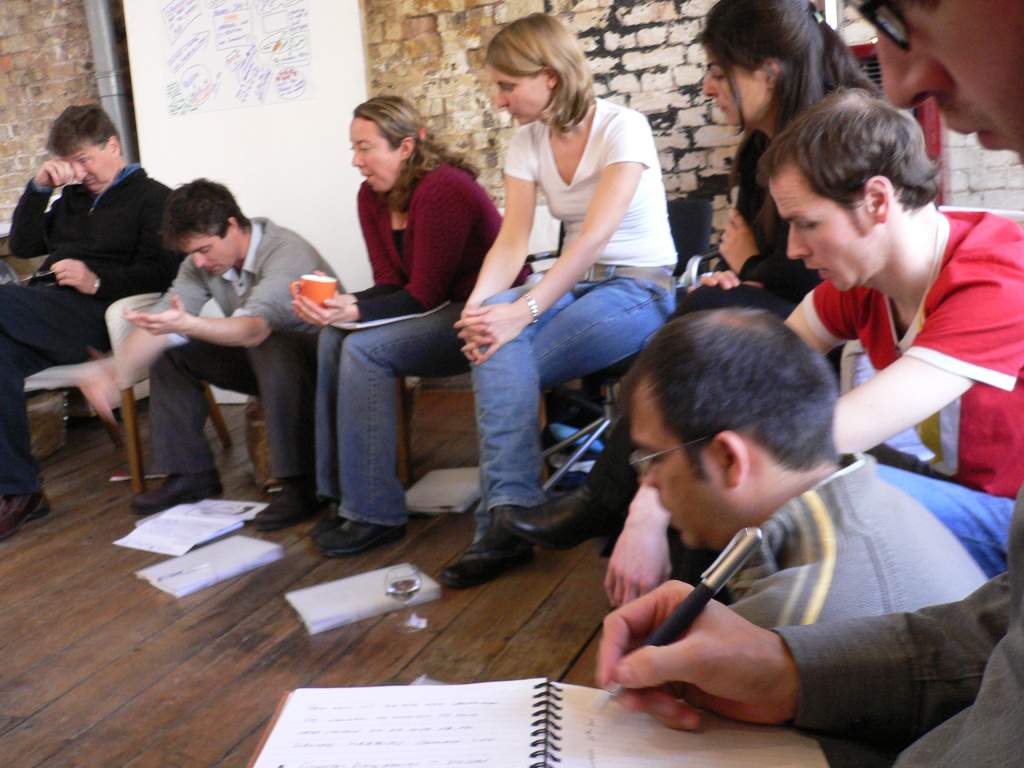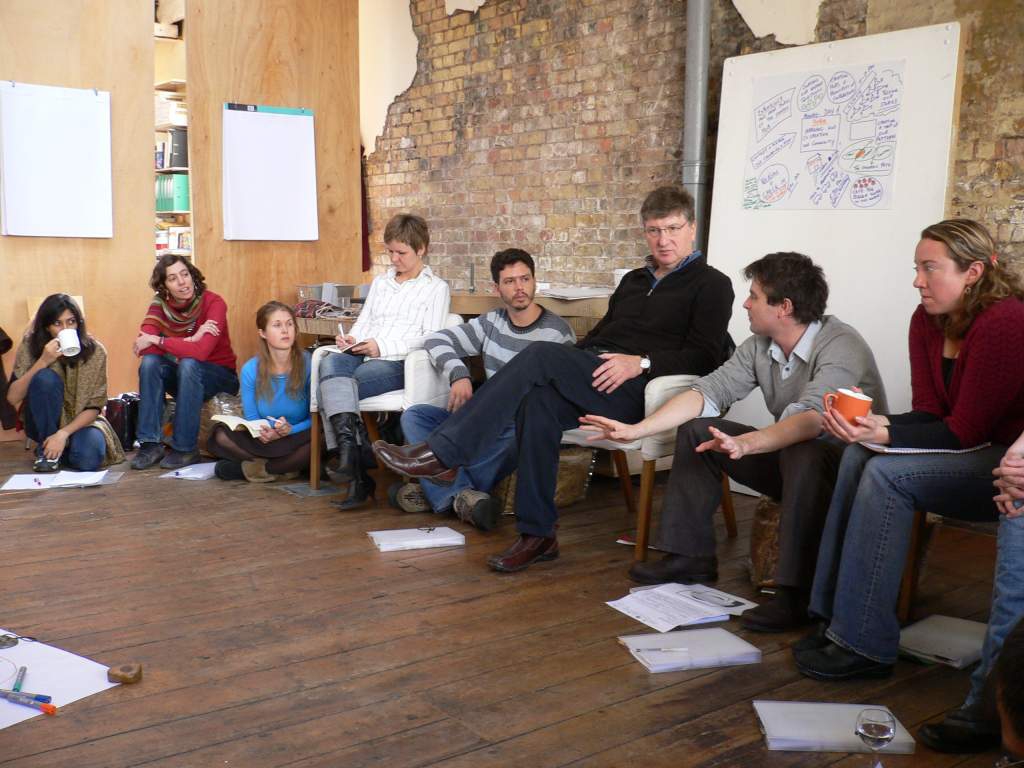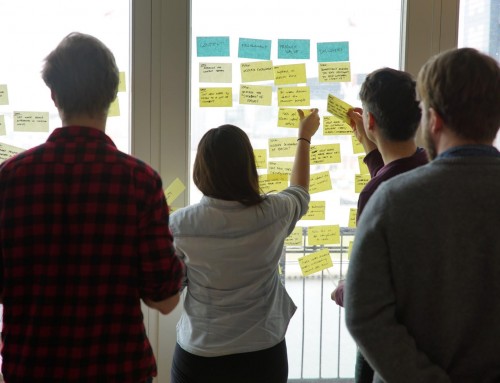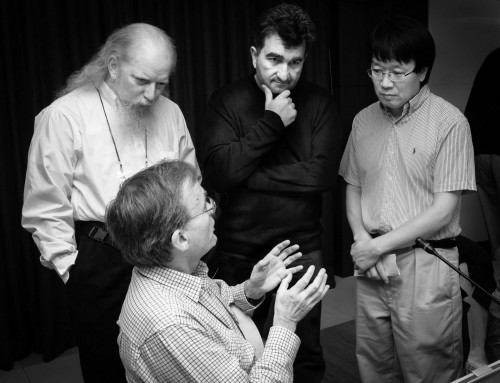Collective Story Harvesting
Main TakeawaysReading Time: 3 minutes Collective Story Harvesting is a storytelling process to unveil multiple aspects, facets, and insights hidden deeply in the experiences of individuals, communities, teams or organisations.
The process is about to sharpen the listening and to concentrate to certain pre-agreed details and topics in the story when it is told.
Description of Collective Story Harvesting
Collective Story Harvesting is a storytelling process to unveil multiple aspects, facets, and insights hidden deeply in the experiences of individuals, communities, teams or organisations. The process is about to sharpen the listening and to concentrate to certain pre-agreed details and topics in the story when it is told.
- First, the participants agree on certain aspects — so called "Arcs" — they are very interested in and which they want to investigate deeper. The notion of "arc" stems from structural story theory: all stories share a common structure, the drama bow. This Bow captures all events, situations, and characters of the story. Arcs decorate the story further by adding details, opening side-stories.
Possible story arcs may include:
- Narrative Arc: the thread of the story – people, events, stages.
- Emotional Arc: facts, emotions and values that are part of the story, etc.
- Process Arc: What interventions, processes, applications, discoveries happened?
- Pivotal Points: When did breakthroughs occur, what was the learning?
- Application: What can we learn from this story for application in our own or other systems?
- Questions: What questions arise from this story that we could ask of any system?
- Specific theme: identify a specific theme, like collaborative leadership, the art of participation, etc, and see what it tells you.
- Principles: What principles of working can be found in this story? What did we learn about participatory practices? What principles of complex living systems were reflected in this work?
- Then, the participants segregate in small groups for each arc chosen.
- The teller shares his experience by telling a story.
- Each group listens to the story told concentrating to their arc in mind. Focusing to the arc, the group members collect and harvest data and related indicators.
- Each group re-creates the story concentrating to their individual arc by resembling the data chronologically.
- Each group presents their stories created to the others and the story teller.
- All, the story teller included, harvest and collect all stories shared to a new, much more enlighted and with much more details richer one.
- The story teller and all participants accept the collectively harvested story offered as a graceful gift.
- The facilitator closes the session with a debriefing of the harvested, enriched story.
Rules of Collective Story Harvesting
- Framing & Introduction: welcome people to the session. Introduce the storytellers. Explain the arcs and ask for volunteers.
- Storytelling: ask the storytellers to tell the story and the group to harvest.
- Collective harvest: ask each of the harvesters to report in on what they found. Take at least as long for this as for the storytelling.
- Response from the tellers: what were the gifts to you from this group harvest? What are you taking away from this session?
- Response from the group: what were the gifts to you from this group harvest? What are you taking away from this session?
- Collective harvesting: come back into the full group. Ask like arc harvesters to sit together in small groups (e.g. people who harvested “Pivotal Points” sit together, Witnesses sit together, etc). Focus the group on a meta harvest question, for example: “What are the conditions for participatory leadership to be successfully introduced in our context?”
Groups then debrief what they have harvested in the context of the full group question. This collective harvest can be done well using a World Café.
- Closing the session: thank you to the storytellers and the harvesters.
For privacy reasons Vimeo needs your permission to be loaded.I Accept
When to use Collective Story Harvesting
- To identify multiple insights and many aspects.
- To take learning to a deeper level.
- Applied learning.
- Full system team building/strategy session.
- Many stories/collective learning.
- Collective meta-learning.
- Creating a new field of work or practice.
- Taking stock at regular intervals during a project’s life.
Facilitator role
- Welcomes and introduces participants to the process.
- Facilitates the collection of the group results.
- Debriefs the process
Further Reading
I do thank Markus Wittwer, who hosted a very inspiring open space session at #ACCDE15 on Collective Story Harvesting.
Page content adapted from the material of Amanda Fenton and ArtOfHosting.
Collective Story Harvesting
Main Takeaways
Reading Time: 3 minutes Collective Story Harvesting is a storytelling process to unveil multiple aspects, facets, and insights hidden deeply in the experiences of individuals, communities, teams or organisations.
The process is about to sharpen the listening and to concentrate to certain pre-agreed details and topics in the story when it is told.
Description of Collective Story Harvesting
Collective Story Harvesting is a storytelling process to unveil multiple aspects, facets, and insights hidden deeply in the experiences of individuals, communities, teams or organisations. The process is about to sharpen the listening and to concentrate to certain pre-agreed details and topics in the story when it is told.
- First, the participants agree on certain aspects — so called "Arcs" — they are very interested in and which they want to investigate deeper. The notion of "arc" stems from structural story theory: all stories share a common structure, the drama bow. This Bow captures all events, situations, and characters of the story. Arcs decorate the story further by adding details, opening side-stories.
Possible story arcs may include:
- Narrative Arc: the thread of the story – people, events, stages.
- Emotional Arc: facts, emotions and values that are part of the story, etc.
- Process Arc: What interventions, processes, applications, discoveries happened?
- Pivotal Points: When did breakthroughs occur, what was the learning?
- Application: What can we learn from this story for application in our own or other systems?
- Questions: What questions arise from this story that we could ask of any system?
- Specific theme: identify a specific theme, like collaborative leadership, the art of participation, etc, and see what it tells you.
- Principles: What principles of working can be found in this story? What did we learn about participatory practices? What principles of complex living systems were reflected in this work?
- Then, the participants segregate in small groups for each arc chosen.
- The teller shares his experience by telling a story.
- Each group listens to the story told concentrating to their arc in mind. Focusing to the arc, the group members collect and harvest data and related indicators.
- Each group re-creates the story concentrating to their individual arc by resembling the data chronologically.
- Each group presents their stories created to the others and the story teller.
- All, the story teller included, harvest and collect all stories shared to a new, much more enlighted and with much more details richer one.
- The story teller and all participants accept the collectively harvested story offered as a graceful gift.
- The facilitator closes the session with a debriefing of the harvested, enriched story.
Rules of Collective Story Harvesting
- Framing & Introduction: welcome people to the session. Introduce the storytellers. Explain the arcs and ask for volunteers.
- Storytelling: ask the storytellers to tell the story and the group to harvest.
- Collective harvest: ask each of the harvesters to report in on what they found. Take at least as long for this as for the storytelling.
- Response from the tellers: what were the gifts to you from this group harvest? What are you taking away from this session?
- Response from the group: what were the gifts to you from this group harvest? What are you taking away from this session?
- Collective harvesting: come back into the full group. Ask like arc harvesters to sit together in small groups (e.g. people who harvested “Pivotal Points” sit together, Witnesses sit together, etc). Focus the group on a meta harvest question, for example: “What are the conditions for participatory leadership to be successfully introduced in our context?”
Groups then debrief what they have harvested in the context of the full group question. This collective harvest can be done well using a World Café. - Closing the session: thank you to the storytellers and the harvesters.
For privacy reasons Vimeo needs your permission to be loaded.
I Accept
When to use Collective Story Harvesting
- To identify multiple insights and many aspects.
- To take learning to a deeper level.
- Applied learning.
- Full system team building/strategy session.
- Many stories/collective learning.
- Collective meta-learning.
- Creating a new field of work or practice.
- Taking stock at regular intervals during a project’s life.
Facilitator role
- Welcomes and introduces participants to the process.
- Facilitates the collection of the group results.
- Debriefs the process
Further Reading
I do thank Markus Wittwer, who hosted a very inspiring open space session at #ACCDE15 on Collective Story Harvesting.
Page content adapted from the material of Amanda Fenton and ArtOfHosting.
: Impact Hub Global Network, via flickr.com • Impact Hub Global Network, via flickr.com, .








Leave A Comment